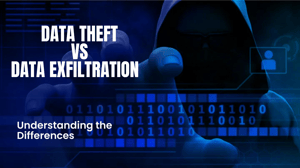
Data Theft vs Data Exfiltration: Understanding the Key Differences
Data theft and data exfiltration, often used interchangeably, refer to unauthorized access and removal of sensitive information. While data theft involves the unauthorized acquisition of data, data exfiltration specifically entails the unauthorized extraction and transmission of sensitive data from a system or network. Understanding these nuances is imperative for implementing effective security measures and safeguarding your organization's valuable information from potential threats.
Understanding Data Theft
Data theft refers to the unauthorized acquisition of sensitive or confidential information. It involves the intentional act of stealing data from a person, organization, or system without their knowledge or consent. The stolen data can include personal information, financial records, trade secrets, intellectual property, and more.
In essence, data theft encompasses a wide range of activities, indicating any unauthorized entry into and extraction of data.

Tackling on Data Theft
Safeguarding your data from theft and loss requires a multi-faceted strategy. On a broader scale, fostering a security-oriented culture within the organization is essential. It is necessary to set up standardized procedures that minimize the chances of data theft and enhance and enforce existing access controls.
One key aspect of creating a security-oriented culture is educating employees about the importance of data protection and their role in maintaining it. Conducting regular training sessions and workshops can help employees understand the potential risks and teach them how to identify and report any suspicious activities. By ensuring that every employee is aware of their responsibilities in protecting sensitive data, organizations can significantly reduce the chances of data theft.
Organizations should have robust access controls in place to restrict access to sensitive data. This includes implementing strong authentication mechanisms, such as two-factor authentication, and regularly reviewing and revoking access privileges for employees who no longer require them. By limiting access to only those who need it, organizations can minimize the risk of data theft.
Unlock the Future of Authentication
Kelvin Zero stands out in the cybersecurity landscape by offering innovative passwordless enterprise solutions. This approach eliminates the need for traditional passwords, reducing the risk of unauthorized access.
SIEM as a Safeguard
Regularly monitoring and auditing data access and usage is also essential in detecting and preventing data theft. By analyzing access logs and user behavior, organizations can identify any unusual or suspicious activities that may indicate a potential data breach. Implementing network monitoring tools and security information and event management (SIEM) systems can help in this regard.
Lastly, organizations should have an incident response plan in place to effectively respond to and mitigate the impact of a data breach. This includes having a designated team responsible for handling security incidents, conducting regular drills and simulations to test the effectiveness of the plan, and having clear communication channels to quickly notify relevant stakeholders in the event of a breach.
Understanding Data Exfiltration
Data exfiltration pertains to the method through which advanced cyberthreats gain access to data and transmit it to a remote system under criminal authority. It distinguishes itself from the act of theft and focuses on the technical procedures involved in surreptitiously extracting stolen data without detection.
Data exfiltration can occur through various techniques such as using malware, exploiting vulnerabilities, or using legitimate channels like email or file transfer protocols. It can often times be challenging to detect because attackers often employ sophisticated techniques to bypass security controls and hide their activities.
Tackling on Data Exfiltration
To mitigate the risk of data exfiltration, organizations should implement strong security measures such as data loss prevention (DLP) solutions, network monitoring, encryption, access controls, and employee training on cybersecurity best practices.
Ensuring the security of your network in the modern landscape necessitates a comprehensive platform, such as Barracuda Network Protection, equipped with next-generation firewall capabilities. This is crucial for identifying and halting data exfiltration. These platforms typically integrate advanced data loss prevention (DLP) features. Through continuous monitoring of outbound traffic and the application of content-based policies, DLP proves highly effective in thwarting the unauthorized extraction of sensitive or critical data from your network.
A robust network protection platform should also conduct thorough scans of both internal and outbound traffic to identify known malware signatures, including command-and-control malware responsible for data movement. Maintaining the solution's effectiveness requires regular updates with the latest signatures. Cloud-hosted SaaS network protection eliminates concerns about updates, as they are seamlessly handled at the server level.
Employing more sophisticated, machine-learning-based analysis of internal traffic enables the detection and prevention of these attempts. It is crucial to implement these preventative measures.

Concluding Thoughts: Moving Forward with Multi-Vector Protection
In conclusion, safeguarding against data theft and exfiltration demands a multi-layered approach.
Implementing advanced network security platforms with features like next-gen firewalls and data loss prevention is crucial. Regular updates, thorough malware signature scans, and leveraging machine learning for advanced analysis are key elements in fortifying defenses.
Ideally, you should ensure comprehensive coverage by employing integrated solutions that exchange threat data in real time. Opting for a truly all-encompassing cybersecurity platform proves to be the most effective strategy in fending off data thieves, reducing data exfiltration risks, and countering various types of cyberattacks.
As cyber threats evolve, staying vigilant and proactive is essential to ensure the integrity and confidentiality of sensitive data in our interconnected digital landscape.
Contact us today to learn more about Datalink Network's comprehensive cybersecurity solutions in order to best protect your organization from data thieves and to minimize exfiltration.



COMMENTS